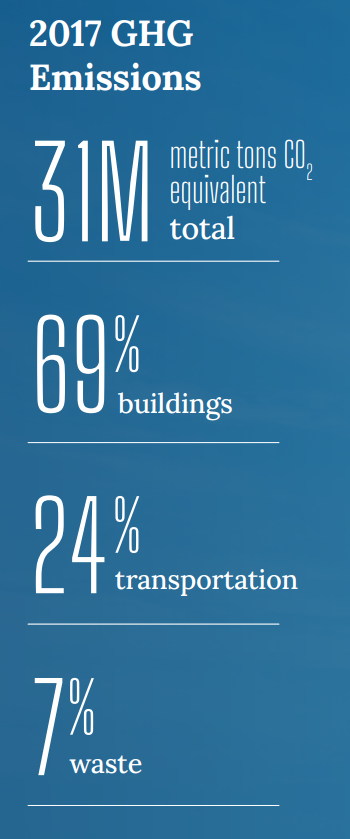Electrify Chicago
An independent tool for viewing City of Chicago building data
According to the
2022 Chicago Climate Action Plan,
69% of Chicago's emissions come from buildings, making
building emissions our biggest challenge and our biggest opportunity as a city
to tackle climate change. At Electrify Chicago, we showcase building performance using
publicly available data supplemented by community-submitted photographs and building
owners.
Start by looking at Chicago's buildings with the highest greenhouse gas intensity i.e. emissions per square foot. Large, efficient, buildings can perform much better than very inefficient small buildings on this metric.
New Article
📰 $30 Million In Missed Fines
The City Of Chicago failed to collect $30 million in potential fines from the building benchmarking ordinance, reducing transparency and accountability.
Legislative update! 🎉
As of late January 2024, legislation is being introduced to require new use more efficient forms of water and space heating, via the Clean And Affordable Buildings Ordinance (CABO), which will reduce the number of highly polluting and inefficient buildings that end up on this site.
If you're in Chicago,
write to your alderman to support the CABO!
Chicago Buildings by Greenhouse Gas Intensity
Note: Data includes large Chicago buildings with data from 2022, unless explicitly stated otherwise.
Note: This data only includes buildings whose emissions are reported
under the
Chicago Energy Benchmarking Ordinance. According to the City “As of 2016,
this list includes all commercial, institutional, and residential buildings larger than
50,000 square feet.” This dataset is also then filtered to only buildings with
reported emissions > 1,000 metric tons CO2 equivalent.
The latest year of data is from 2022, but we update the site regularly when new data is available, and some buildings may have failed to report that year, and only have older data available.
| Property Name / address | Primary Property Type |
Greenhouse Gas Intensity (kg CO2 eq./sqft) |
Total Greenhouse Emissions (metric tons CO2 eq.) |
|---|---|---|---|
|
200 N LaSalle Ave
200 N LaSalle Ave
| Office | 6.0 kg/sqft
Lowest 42%
| 4,217 tons
Highest 9%
|
|
515 North State
515 N STATE ST
| Office | 6.0 kg/sqft
Lowest 42%
| 4,543 tons
Highest 8%
|
|
525 W Monroe St
525 W Monroe St
| Office | 6.0 kg/sqft
Lowest 42%
| 6,155 tons
Highest 5%
|
|
5220 S DREXEL AVE
5220 S DREXEL AVE
| Multifamily Housing | 6.0 kg/sqft
Lowest 42%
| 321 tons
Lowest 10%
|
|
Daley
🕰️
7500 S Pulaski Ave
| College/University | 6.0 kg/sqft | 2,999 tons |
|
Dixon Building
411 - 415 S Wells St
| Office | 6.0 kg/sqft
Lowest 42%
| 347 tons
Lowest 12%
|
|
The Gage Commericial Condominium Building
18 28 S Michigan Ave
| College/University | 5.9 kg/sqft
Lowest 40%
| 1,241 tons
Highest 38%
|
|
61 E Banks Street
61 E Banks Street
| Multifamily Housing | 5.9 kg/sqft
Lowest 40%
| 791 tons
Lowest 45%
|
|
1920 N Milwaukee Ave
1920 N Milwaukee Ave
| Multifamily Housing | 5.9 kg/sqft
Lowest 40%
| 360 tons
Lowest 14%
|
|
Astor Villa Condominium Association
1430 N Astor St
| Multifamily Housing | 5.9 kg/sqft
Lowest 40%
| 658 tons
Lowest 38%
|
|
Ainslie Park Condominium Association
840 846 W Ainslie St
| Multifamily Housing | 5.9 kg/sqft
Lowest 40%
| 312 tons
Lowest 9%
|
|
Mercy Housing Lakefront?s Englewood Apartments
901 W 63rd St
| Multifamily Housing | 5.9 kg/sqft
Lowest 40%
| 371 tons
Lowest 14%
|
|
-
5630 N Sheridan Ave
| Multifamily Housing | 5.9 kg/sqft
Lowest 40%
| 1,418 tons
Highest 33%
|
|
-
917 W Eastwood Ave
| Multifamily Housing | 5.9 kg/sqft
Lowest 40%
| 449 tons
Lowest 22%
|
|
Ray Elementary -CPS
(CPS)
5631 S Kimbark Ave
| K-12 School | 5.9 kg/sqft
Lowest 40%
| 680 tons
Lowest 39%
|
Data Source:
Chicago Energy Benchmarking Data
